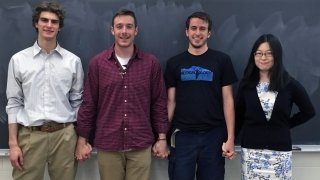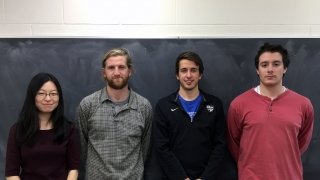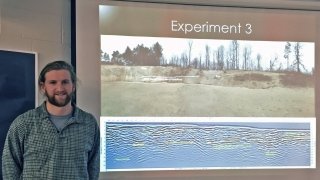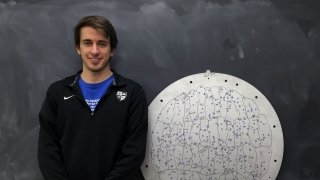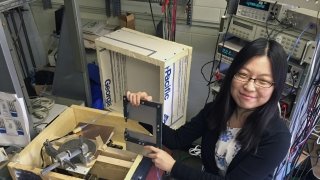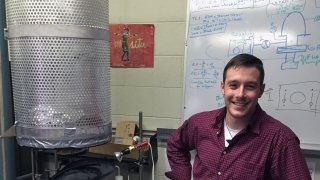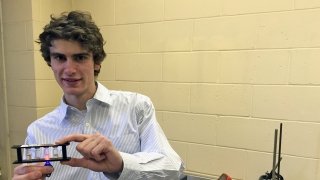Senior Research Projects 2015 - 2016
Seniors present to the physics department the results of their Phys 489/490: SYE Advanced Laboratory and Phys 499: Honors SYE research projects at the end of each semester. The abstracts for their research are below and photos of the student presenters follow afterwards:
Fall 2015
Ground-Penetrating Radar Applications in Northern New York - Austin Hart '16
Ground-penetrating radar (GPR) is a geophysical, non-destructive technique to determine boundaries beneath the ground surface. Specifically, a boundary can be defined as any contrast in the electric properties in the subsurface. A GPR system transmits a radio wave into the ground, the wave propagates through the ground until it reaches a boundary, where part of the wave is refracted deeper, and part is reflected back to the surface. The time between signal transmission and its return to the surface can be calculated to determine the depth in the boundary. Stratigraphic layers, foreign objects, and the presence of solvent (like water or a contaminant) in the pore space can all yield significant electrical contrasts to be detected by a GPR system. In this study, we performed three different GPR surveys to practice different applications: 1) We measured known utilities in the ground, 2) we mapped groundwater elevation on a small parcel, and 3) we surveyed a sand deposit to infer its historic depositional setting. We found agreement between a utilities site map and our survey results. We registered water table reflections to generate a 3D surface of the water table that tends to follow topography with slight perturbations. And, we identified multiple depositional features within the sand pit to speculate how the deposit fit into a timeline of glacial retreat in this area..
For more information, contact Dr. Catherine Jahncke
Selecting Photometric Targets for the Arecibo Pisces-Perseus Supercluster Survey (APPSS) - Evan Smith '16
The Arecibo Pisces-Perseus Supercluster Survey (APPSS) seeks to investigate the missing satellites problem and probe the existence of dark matter around the Pisces-Perseus Supercluster, which is informally called the ‘ridge region’ because of its ridge–like shape. In order to accomplish these goals, data on more galaxies surrounding the ridge region is needed. Statistical analysis of the masses of these galaxies with their infall speeds (the speeds at which these galaxies are falling into the ridge region) will lead APPSS to a calculation of the amount of mass in the Pisces – Perseus ridge region.
It is possible to refine the target selection process using the stellar mass to light ratio (Bell 2003), which is a value unique to each galaxy and relates the amount of stellar mass to the luminosity in a certain wavelength band. Work has been done tying the amount of stellar mass there is in a galaxy compared to how bright it is at a certain wavelength, called the mass to luminosity ratio. This can be used in conjunction with a relationship between the HI mass and the stellar mass found by Huang et. al. in their 2012 paper. With this relationship, the desired range of HI masses should correspond to a range of stellar masses, which should correspond to a range of magnitudes at different bands, using the mass to luminosity ratio.
Observations of targets selected in the Virgo cluster, using the original criteria of optical qualities, were made in the spring of 2015. These observations provide an important testing ground for the effectiveness of using photometric data to select good targets for radio observations of the 21 cm line, since we already know the success rate of the target selection. 115 of the 161 targets were detected, a 71% success rate. The process of using the mass to luminosity ratios, or M/L ratio for short, for selecting radio targets is explained in depth in the procedure section and implemented to the spring 2015 observations in the experiments section.
For more information, contact Dr. Aileen O'Donoghue
Spring 2016
Genesis of the Dragon Lady: Chien-Shiung Wu’s Years in China and Her Contribution to the Discovery of Non-conservation of Parity in Beta Decay - Xiaoying Claire Lu '16
Chien-Shiung Wu (1912-1997), a Chinese-American experimental physicist, is famous for her contributions in nuclear physics. We studied her childhood and education in China before she moved to the United States and studied physics at the University of California, Berkley. She grew up in one of the most turbulent periods in the history of China, during a period of conflict between modern Western science and traditional Chinese values. Because this cultural conflict is not often in addressed in western biographies of her, we supplemented Western literature, with sources in Chinese. Her family tradition put her in a unique position culturally, and we found that her education was representative of that cultural collision. However, her path was very similar to those of the other particularly successful women physicists of the twentieth century.
The experiment for which she was known shows that conservation of parity, considered at the time a fundamental principle, was violated in beta-decay. The parity experiment, in her own words, was a “sudden liberation of our thinking on the very structure of the physical world” (Wu, 1973), and won T. D. Lee and C. N. Yang the Physics Nobel Prize for proposing the experiment. Wu’s later research expanded to Mössbauer spectroscopy as well as Bell’s theorem. Towards the end of her career she was a strong advocate for women in science, and she is an important role model for many Chinese students with scientific aspirations today.
For more information, contact Dr. Karen Johnson
Experimental Study of the Sensitivity of the Hall Resistance for a Square Four-Point Probe on a Bismuth Circular Sheet - Xiaoying Claire Lu '16
The Hall Effect, first observed by E.H. Hall in 1879, happens when electrical current passes through a conductor placed in a magnetic field. The Hall measurement continues to be used as a technique for characterizing the electrical transport properties of metals and semiconductors, since it determines the density of free charge carriers in the sample. Koon and Ole Hansen et al. simulated the response of a Hall square four-point probe to a circular region of a nonzero magnetic field on an infinite sheet of uniform material composition, as a function of normalized sample size. To verify the simulation, we created a local magnetic field by using a magnetic circuit consisting of a small rare earth magnet and soft iron. The specimen we used is a Bismuth disc with radius of 9 cm and calculated thickness of 0.03 cm. We can characterize the local Hall signal of the Bismuth disc sample by moving the square four-point probe and the magnetic field together. By measuring the Hall resistance with the square four-point probe fixed at the center of the Bismuth sample, while moving the magnetic circuit, we can find the normalized measured Hall resistance and compare the result with the simulation.
For more information, contact Dr. Daniel Koon
Hydriding Rare-Earth Palladium-Magnesium Lamellae - Harrison Schwarzer '16
Magnesium/Palladium lamaella (thin sheets) will be saturated with Hydrogen, and the rate at which hydride forms measured in the presence of different RE metals. Absorption and desorption rates are measured by Van der Pauw method and four-point probe.
For more information, contact Dr. Daniel Koon
Photovoltaic Efficiency Enhancement with Fluorescent Nanoparticles - Zachary Sutton-Giglia '16
This project is designed to measure the performance of a solar cell under surface depositions of fluorescent nanoparticles to the front surface of the cell. Nayfeh et al. demonstrated an improved efficiency in polycrystalline silicon solar cells when fluorescent nanoparticles were applied to the bare front surface. We tested the performance of the solar cells before, and after, they were treated with similar nanoparticles, called quantum dots, and compared the performances. Performance was tested by measuring the output power over a range of load resistances beginning with the short circuit current and ending with the open circuit voltage. Measurements were taken under two types of illumination: halogen (peak wavelength at 600nm) and black light (peak wavelength under 380nm). Improvements in the efficiency were observed to be ≈14% under black light illumination, and ≈8% under halogen bulb illumination for solar cells treated with nanoparticles compared to untreated solar cells. Performance enhancements suggest a potential role for nanoparticle treatment in the commercial manufacturing of photovoltaics.
For more information, contact Dr. Catherine Jahncke

